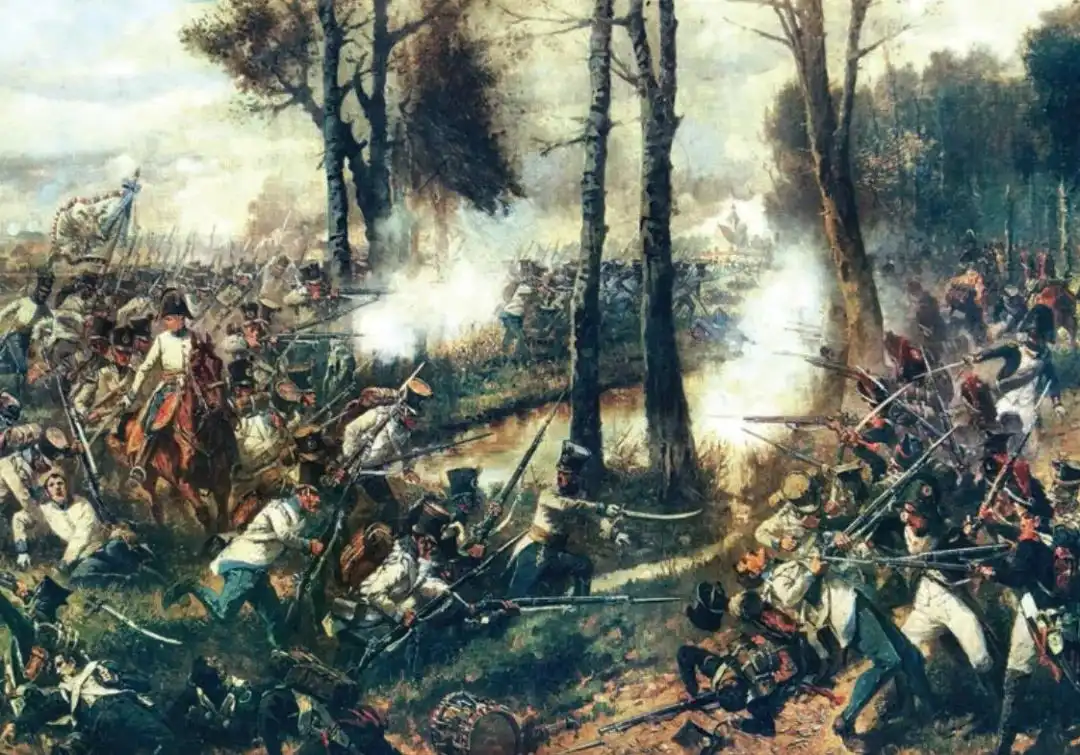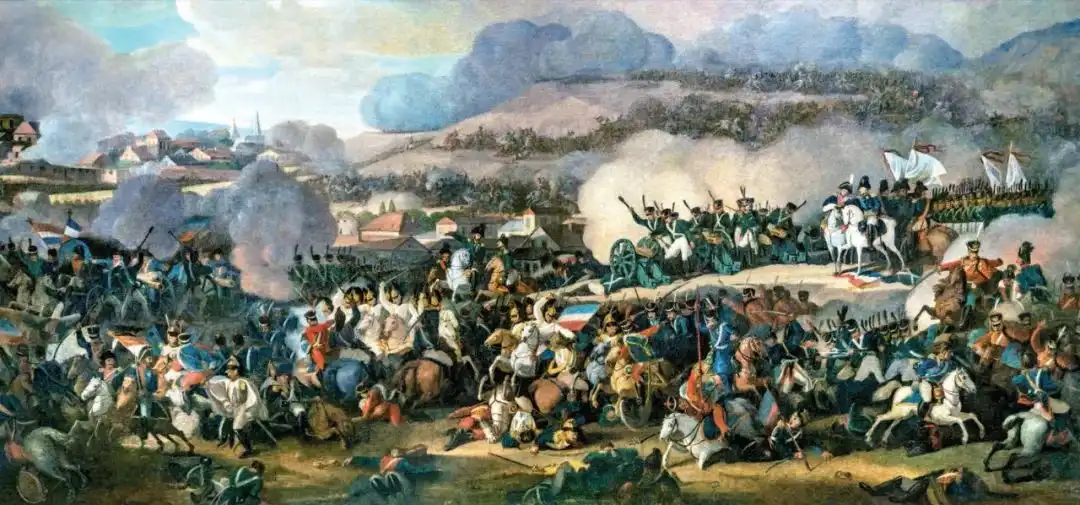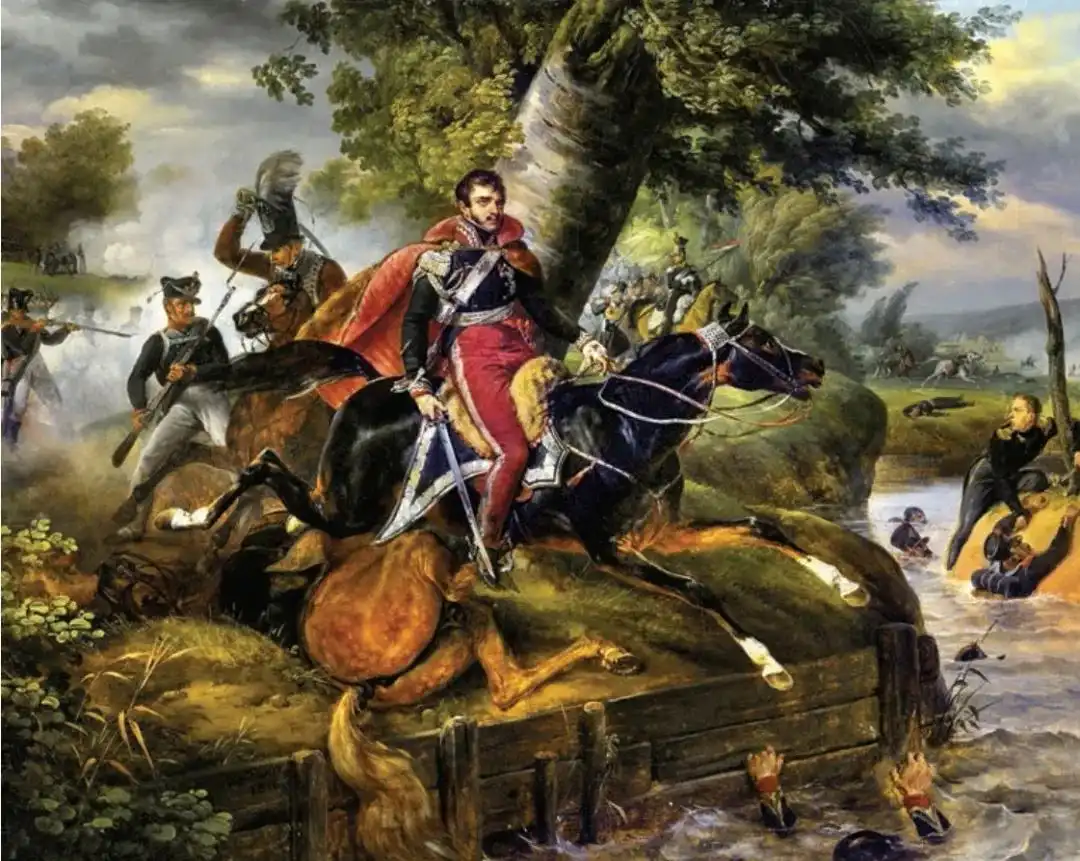battle of Leipzig:The dusk of the Napoleonic Empire
Although the Battle of Waterloo is often regarded as the end of the Napoleonic Empire, a large-scale battle near Leipzig the year before had actually determined France's defeat.
The anti-French coalition troops were divided into three groups
On September 6, 1813, in Denneuwitz, 60 kilometers southwest of Berlin, two armies engaged. One was the French army led by Marshal Ney and the other was the Prussian-Swedish coalition. As a result, Ney fell into a trap, and the French army lost 24,000 men and 50 cannons. Ney wrote in a letter to his emperor Napoleon I:"The will of generals and officers was shattered, and our foreign allies fled at the first opportunity they had." Napoleon still seemed calm, but privately he was angry at Ney's incompetence, because the failure ruined Napoleon's efforts to take the initiative and resolve the Sixth Anti-French Alliance as soon as possible.

Prussian and French soldiers fight fiercely in the woodland near Leipzig
Over the past year or so, the situation in China and Europe has undergone tremendous changes. In June 1812, Napoleon led 500,000 troops into the vast land of Russia. By the time the defeated French retreated across the border in November of that year, only 35,000 people remained in the magnificent French army. In the following December, Napoleon rushed back to Paris to form a new army, and the victorious Russian army marched into East Prussia. As the myth of Napoleon's invincibility was shattered, Prussia attempted to resist again and formed a new round of anti-French alliance with Russia, Austria, Sweden, Britain, Portugal, and Spain.
By mid-April 1813, the French emperor had managed to assemble a new army, including survivors of the Russian Expedition, Spanish battlefield veterans, National Guard and conscripts from 1813, as well as troops from French allies such as Baden, Württemberg, Saxony, Italy and Poland.
The army is full of young recruits who lack experience, low morale and, more importantly, many lack the spiritual bonds that lead to serving together on the battlefield. Another serious shortcoming of the French army was its lack of cavalry. Due to the catastrophic losses of its horses on the Russian battlefield, Napoleon was unable to rebuild this service that had brought him infinite glory. The lack of cavalry will severely limit the French army's ability to conduct reconnaissance and attack in the upcoming battle.
By August 1813, Napoleon was able to mobilize more than 100,000 troops, but the anti-French coalition forces could muster twice that number. In order to defeat Napoleon, the coalition troops were divided into three groups:Swedish Crown Prince Bernadotte commanded the Northern Army composed of Russians, Prussians and Swedes; Prussian Marshal Blücher led the Prussian coalition forces in the middle; the Bohemian Army was the largest of the three armies, composed of Austrians, Russians and Prussians. Austrian Marshal Prince Schwarzenberg not only commanded the army, but also was the commander of the three armies. When Schwarzenberg established his headquarters in Rosha, the three emperors:Tsar Alexander I of Russia, Emperor Francis II of Austria, and King Frederick Wilhelm III of Prussia also ruled here.

At the critical moment on the afternoon of October 18, 1813, Bernardotte's Swedish troops joined the battle
At this time, Napoleon had established a base camp in Dresden. His plan was to rely on the advantage of inside combat to defeat three opponents one by one on the front line of the Elbe River. However, after Ney's failed engagement, Napoleon had to turn in the direction of Leipzig. After realizing that Schwarzenberg's Bohemian Corps was the closest coalition force to Leipzig, Napoleon was determined to defeat this opponent first.
Array along the river
Napoleon arrived in Leipzig at noon on October 14. At this time, the sound of fighting between the French outpost and the Schwarzenberg outpost could be heard from the south. After gathering all available troops, Napoleon had 177,000 men and 690 artillery pieces available in Leipzig, while 14,000 men of the Seventh Army were still on their way.
In comparison, the three-way anti-French coalition forces have a total of 334,000 people and 1500 artillery pieces. Among them, the Bohemian Army has arrived in the Leipzig area with a strength of 203,000; Blücher's Army's 64,000 are rapidly approaching; Bernardotte's Northern Army's 67,000 are still some way off.
The two sides set up positions on the 15th and made plans for the next day's battle. Napoleon gave Marshal Murat overall command of the southern flank of the French army, where troops included:Marshal Victor's 2nd Corps, General Lauriston's 5th Corps, Marshal Augerot's 9th Corps, General Frian's 1st Elderly Guards Division, General Nansoti's Guards Cavalry Corps, and General Mauburg's 1st Cavalry Corps.
French middle and reserve teams include:Poniatowski's 8th (Poland) Corps and 4th (Poland) Cavalry Corps, Marshal McDonald's 11th Corps, General Sebastiani's 2nd Cavalry Corps, General Curial's 2nd Elderly Guards Division, Marshal Odiu's 1st Young Guards, Marshal Motier's 2nd Young Guards and General Drut's Guards artillery.
Marshal Ney has overall command of the northern region of Leipzig, and his troops include:General Suham's 3rd Corps, Marshal Marmon's 6th Corps, General Bertrand's 4th Corps, and General Ariji's 3rd Cavalry Corps.
Napoleon planned to take the initiative and defeat Schwarzenberg between the Pryce and Pat rivers. The coalition forces 'plans were tit-for-tat, preparing to launch an attack based on the right bank of the Price River. Schwarzenberg entrusted Barkley with the important task. His troops consisted of General Klenau's 4th Austrian Corps, General Platov's nine Cossack cavalry regiments, and Russian general Wittgenstein's battle group-this battle group included General Gorchakov's 1st Corps, Prince Eugen's 2nd Corps, General Norrendorf's 2nd Prussian Corps, and General Palen's Russian cavalry.
In the center between the Pryce and Pat rivers was deployed General Melwitt's Second Austrian Corps, and on his flank was Marshal Gyule's Third Austrian Corps.
The reserves stationed in Rosha were commanded by Archduke Constantine, brother of Tsar Alexander I, and included General Raevsky's 3rd Russian (Grenadier) Corps, General Yermolov's Russian and Prussian Guards, and General Golitzin's Russian Cavalry Guards.
the first day of the battle
On the morning of October 16, Napoleon ordered Ney to start action at 7 a.m. However, after the earthquake and fog dissipated, Buckley advanced his army along the right bank of the Price River, and the Battle of Leipzig began. The Russian 1st Army attacked Liebert Volkwitz, and the Russian 2nd Army led by Eugene attacked Vasho. The battle for Washoe was brutal, and after the destroyed village changed hands several times, the French barely retained it.
Unable to get the first move, Napoleon began to mobilize reserves to support the front line, and at the same time he also prepared the Old Guards and Murat's cavalry for attack. At this time, the Austrian 2nd Corps on the left flank of the Bohemian Army crossed the swamp between the Pryce and Elster rivers and attacked the right flank of the French army, where they engaged in fierce battles with the Polish troops led by Poniatowski.

Russian grenadiers are resisting the attack of French cavalry
After three hours of fighting, the coalition forces failed to make any progress and the momentum of their offensive began to wane. Buckley's infantry, unable to advance in the face of heavy French artillery fire, began to retreat backward. Seeing that the pressure had eased, Napoleon judged that the time was ripe for a counterattack. He ordered Lauriston, Victor, and Augero's troops to attack Buckley, while attacking the opponent's relatively weak central area with two cavalry troops. MacDonald and Sebastiani's troops would encircle the right flank of the coalition forces, trapping Buckley in the swamp on the River Price.
The French attack began at noon. Two hours later, French artillery fire had ruthlessly damaged the front line of the Bohemian Army. The casualties of the Russian Second Army were particularly serious, with some battalions being reduced to company size. Across Buckley's entire front line, Russian and Prussian troops were retreating under heavy pressure, except Raevsky's grenadiers, forming a square formation, remained stable.
At Murat's instructions, General Mauburg personally led six French heavy cavalry regiments and two Saxon cavalry regiments to launch a charge. They not only made a gap in Prince Eugen's line, but also began to approach Alexander I's command post dangerously. The tsar had to order the Russian and Prussian Guards, as reserves, into action.
The French seem to be on the verge of victory. "The world is still turning for us!" Napoleon shouted to his secretary, Agathon Fern. However, Buckley mobilized his heavy cavalry in time to fill the gap in the defense line torn by the French cavalry, and the coalition forces used fast-moving horse-drawn artillery to strengthen their firepower. The cannons fired fiercely, the French cavalry fell off their horses, and the shells broke one of Maobao's legs. "Why are you crying?" Facing amputation, the general told the tearful valet:"You can save one boot."
Elsewhere on the battlefield, General Platov's Cossacks operated to further suppress the French cavalry, while the Russian and Prussian Guards in the reserve also stabilized the situation.
Previously, due to a shortage of cavalry, Napoleon was not sure how far Blucher was from Leipzig, but he believed that the coalition forces would not move too quickly. But he was wrong. That afternoon, Blücher's troops entered battle north of the battlefield. Based on the erroneous judgment that Blücher was still far away, many of Marshal Ney's troops had been transferred to the southern flank before, which enabled the Prussians to quickly occupy the important town of Mokken. But as night fell, Blücher was unable to expand the results.
The day's battle ended. The coalition forces suffered 30,000 casualties in Leipzig, while the French lost 25,000 people. In Napoleon's time, a battle usually ended in one day, but the Battle of Leipzig was different and would continue.
Continuation begins
The first day of fighting is over. Should we stay and continue fighting or leave? Napoleon knew that his reinforcements were only 14,000 men from the Seventh Corps, while his opponents expected a large number of reserves to arrive, including Bernardotte's Northern Army and the Polish Army led by Russian general Benichon. Although he was at a disadvantage, Napoleon did not want to admit defeat. Failure here would mean giving up control of Germany and the tens of thousands of troops stationed on the Elbe, Ode and Vistula rivers.
October 17 arrived, both sides were waiting for reinforcements, and there was little action on the Leipzig battlefield. On this day, Napoleon proposed a truce to the Austrian emperor Francis II, but the monarch ignored the proposal. After the Seventh Army arrived on the battlefield, Napoleon readjusted his deployment that night and deployed the main force in a semicircular position between the Pryce and Pat Rivers.
At about 7 o'clock in the morning the next day, when the mist began to dissipate, the coalition artillery fired on all sides, and a new stage of the Battle of Leipzig arrived. Faced with the impact of the superior coalition forces, the outermost French front detachment fought fiercely, but was slowly repelled. After approaching Probstida, Buckley stopped and waited for friendly troops Benyeson to come forward. When the two troops began to act jointly, the battle also entered its climax.
Buckley's troops stormed Probstida, a key fulcrum of the French central position. The elite soldiers of the 2nd and 5th Corps were stationed there. There were 50 cannons on each side of the village. Behind them, the elderly Guards were ready. However, the attacking side had the advantage of strength, and the Prussian troops, supported by artillery fire, broke into Probstida and then engaged in a tug-of-war with the French. With the cooperation of the Russian army, the Prussian army once controlled the area, but was expelled by the counterattack of the elderly Guards.
On the left side of the battlefield, Austrian reserves led by Prince Louis William crossed the River Price, captured Dolits, and from there attacked Poniatowski's Polish troops. Napoleon threw in the Young Guards in this direction, and they once recaptured Dolits, but were soon recaptured by the Austrians.
The other two allied forces also took action. Blücher's regiment had been attacking on the north flank of the battlefield all morning. The slowest Bernardote's regiment finally crossed the Pat River at noon. At about 15 p.m., Bernardotte pressed his troops towards Leipzig, joining him with Benichon's troops on the far right side of the coalition line.
100,000 casualties on both sides
Bernadotte and Bennenich joined forces to attack Sellerhausen in the eastern suburbs of Leipzig, where in addition to the French, there was also a Saxon infantry division, its allies. However, under the pressure of the coalition forces, the Saxon division surrendered to Bernardotte with their cannons. The Saxons surrendered to their opponents so quickly that the French soldiers cheered them because they thought they had launched a fierce attack.

Victors on the battlefield:The three people in the center on the right side of the picture are the Russian Tsar, the Austrian Emperor and the King of Prussia
Bennichon quickly seized the opportunity. He gradually poured Russian and Prussian troops into the gap in the French line. After that, Bernardotte asked Marshal Stedink to lead the Swedish army into battle. By this point, the Anti-French Alliance troops had occupied three positions outside Leipzig, and the only way for the French to leave the area was in the western suburbs.
After night fell, Napoleon finally gave the order to retreat. At his request, the logistics column left the battlefield first, followed by the Old Guards, followed by the Young Guards, followed by the 9th Corps and 2nd Corps, and finally the cavalry troops. Napoleon appointed Macdonald and Poniatowski's troops as defenders. In view of Poniatowski's "bravery and loyalty", Napoleon promoted the Polish general to the rank of Marshal and awarded him the Marshal's Scepter on the battlefield.
By dawn on October 19, most of the French army had withdrawn from the Leipzig battlefield, and it was not until two hours after sunrise that the generals of the Anti-French Alliance realized that the French had completely retreated. After 10 a.m., the coalition forces launched a final attack on the French rear troops. About an hour later, Napoleon and his entourage arrived in Lindenau on Erster, while at the same time King Frederick Wilhelm III of Prussia rode into Leipzig and was warmly welcomed by ecstatic civilians.

The picture shows Marshal Poniatowski, drowning in Lindenau
Shortly after noon, French engineers prematurely blew up the Lindenau Bridge, trapping 20,000 French rearguard soldiers on the other side of the Elster River. Thousands of people jumped into the water and tried to swim across the river, including Poniatowski. However, he had suffered two injuries in previous battles and was frail. As a result, he drowned 12 hours after receiving the Marshal's scepter from Napoleon.
Napoleon led the remnants of his army to retreat westward, and the victorious coalition commander decided not to pursue. The Battle of Leipzig was known as the "National Battle" because of the diversity of the countries in which it participated. It was one of the largest and most decisive battles of the Napoleonic Wars.
During the battle, the French army suffered 43,000 casualties, 38,000 were captured, and 6100 people defected during the battle. The French army's list of senior casualties includes Polish Marshal Poniatowski, 11 generals killed, 12 wounded generals and 36 captured generals. The French also lost 325 cannons and most of their supply vehicles. The casualties of the anti-French coalition forces also reached 54,000, with the Russian and Prussian troops particularly heavy, but the victors were able to enjoy the joy of the victory.
With the defeat in Leipzig, Napoleon's rule east of the Rhine came to an abrupt end on November 2. In January 1814, the Anti-French Alliance invaded French mainland. Three months later, the French emperor Napoleon announced his abdication. The era of Napoleon was coming to an end, but the last scene was still missing.
copyright notice:This article was published in the 3rd issue of Military Digest in 2024. The author:Hung-chien, Liu Wei, If you need to reprint it, please be sure to indicate "Transferred from Military Digest".
attention to our

